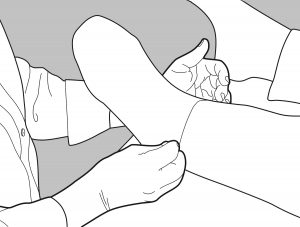Trauma Training Tip
Our bones and teeth are the tissues associated with the Water Element. Researchers at Columbia University, using mice as subjects, have made some fascinating discoveries about the role of our bones in the self-protective response; and in whole-body regulation.
Their research focuses on the role of osteocalcin, a bone-derived hormone. They conclude that the stress response is initiated by osteocalcin, which then signals the adrenal gland to initiate the “fight or flight” signal in the body.
Osteocalcin is clearly a “Water” hormone. Their research demonstrates its role in supporting pre-natal brain development, cognitive functions such as learning and memory, and neurotransmitter production of serotonin, dopamine, and catecholamine. It stimulates the release of insulin into the bloodstream and improves the uptake of glucose by cells in the entire body – making it a profound influencer of energy metabolism – and supporting our capacity to fight or flee. It also influences the production of testosterone and influences male fertility.
Interestingly, the kidney and adrenal glands, as well as our brain, bones and its marrow, our aging process, hormone regulation, and essential vitality all correspond with the role of the Water Element of Acupuncture and Asian Medicine (AAM). When we touch any of these tissues or structures we influence all of them.
Osteocalcin levels, like what AAM refers to as Jing or essential vitality, decreases with age and is one analysis for weaker muscles, osteoporosis, and cognitive decline associated with aging. Osteocalcin levels, also similar to Jing, are depleted in threat signaling. This research gives new understanding and approaches to help the multi-symptom impact of traumatic stress.
 Providers may choose to make mindful contact with a bony protuberance at a comfortable location in their patient’s body. Those whose license includes the repair of tissues can touch with an intention around healing bones as well as whole-body integration. Those whose license is more focused on integrating the psychological impact of traumatic stress can use this touch to access deeper dimensions of their client’s psychological and cognitive health.
Providers may choose to make mindful contact with a bony protuberance at a comfortable location in their patient’s body. Those whose license includes the repair of tissues can touch with an intention around healing bones as well as whole-body integration. Those whose license is more focused on integrating the psychological impact of traumatic stress can use this touch to access deeper dimensions of their client’s psychological and cognitive health.
Alaine’s Two Cents
The more I immerse myself in an integrative exploration of the human response to stress, the more impressed I am by the wisdom of AAM.
The scientists at Columbia are bringing modern study that affirms the relationships and functions that ancient Chinese people understood through their tools of observation and inquiry of the laws of nature. These wise people didn’t know about osteocalcin, but they understood the impact of profound fear on our bones, the essential role of the Kidney as the source of the yin and yang of all the body’s organs, and the influence of advanced age on our bones and our vitality.
I love it when East meets West for integrative healing!
Check This Out!
Here are a couple of articles about osteocalcin and its role in bone and body health and vitality.
Bone, not adrenaline, drives fight or flight response
Clinical Curiosity
Where is your clinical curiosity carrying you?
Send me a question or two and I will explore them with readers in this corner next month.
Q. In my practice with active duty service members, I encounter mostly people who are stuck in arousal, but every now and then I get someone who is stuck in collapse. They offer very few words, aren’t very engaging with me, get on the table and promptly close their eyes and zone out even more. I was reviewing my notes from our classes to see if they are treated in the same way, but I can’t find anything one way or the other. Is there anything different I should be doing to get them engaged from the collapse?
A. Great question! First thing to remember is that people only land in collapse because their mobilization response wasn’t successful. So — while they appear passive, underneath that “zone out” is an experience of very high arousal. Their system went into collapse to buy them time, save energetic resources, provide them with some pain-killer endorphins and protect their heart from hyper-arousal. Their arousal is actually very high — and hidden underneath their collapse.
 They need this restorative state right now. This is a time to be very aware of the concept of titration — you will want to bring them out of this freeze state very slowly. If they come out too fast, they will go rapidly to the experience that put them into this collapse in the first place. We want them to first move from dorsal vagal high tone (freeze) to the deeply restorative dorsal vagal low tone.
They need this restorative state right now. This is a time to be very aware of the concept of titration — you will want to bring them out of this freeze state very slowly. If they come out too fast, they will go rapidly to the experience that put them into this collapse in the first place. We want them to first move from dorsal vagal high tone (freeze) to the deeply restorative dorsal vagal low tone.
Safety and relationship are your key words. Invite them to choose which end of the table they place their head and to look for comfort in the table and in the room. Arrange their pillows just right — invite them to micro-mange their comfort. They may want adjustments to the shades on the windows, know that the door is locked, or that you place yourself on one side of them or the other.
I would use the kidney/adrenal hold and especially if they have any bone injuries, to explore using mindful touch on the distal end of a relevant bone. They may also benefit from warmed yoga eye-pillows underneath each of their kidneys — and can even tuck a pair into the back of their shirt, allowing them to rest just above their belt.
They might also benefit from questions like: When did you know you were home safe? or When did you know you were going to be ok?
Hope this helps! All good wishes to you and to your patients. Thank you for your work.


